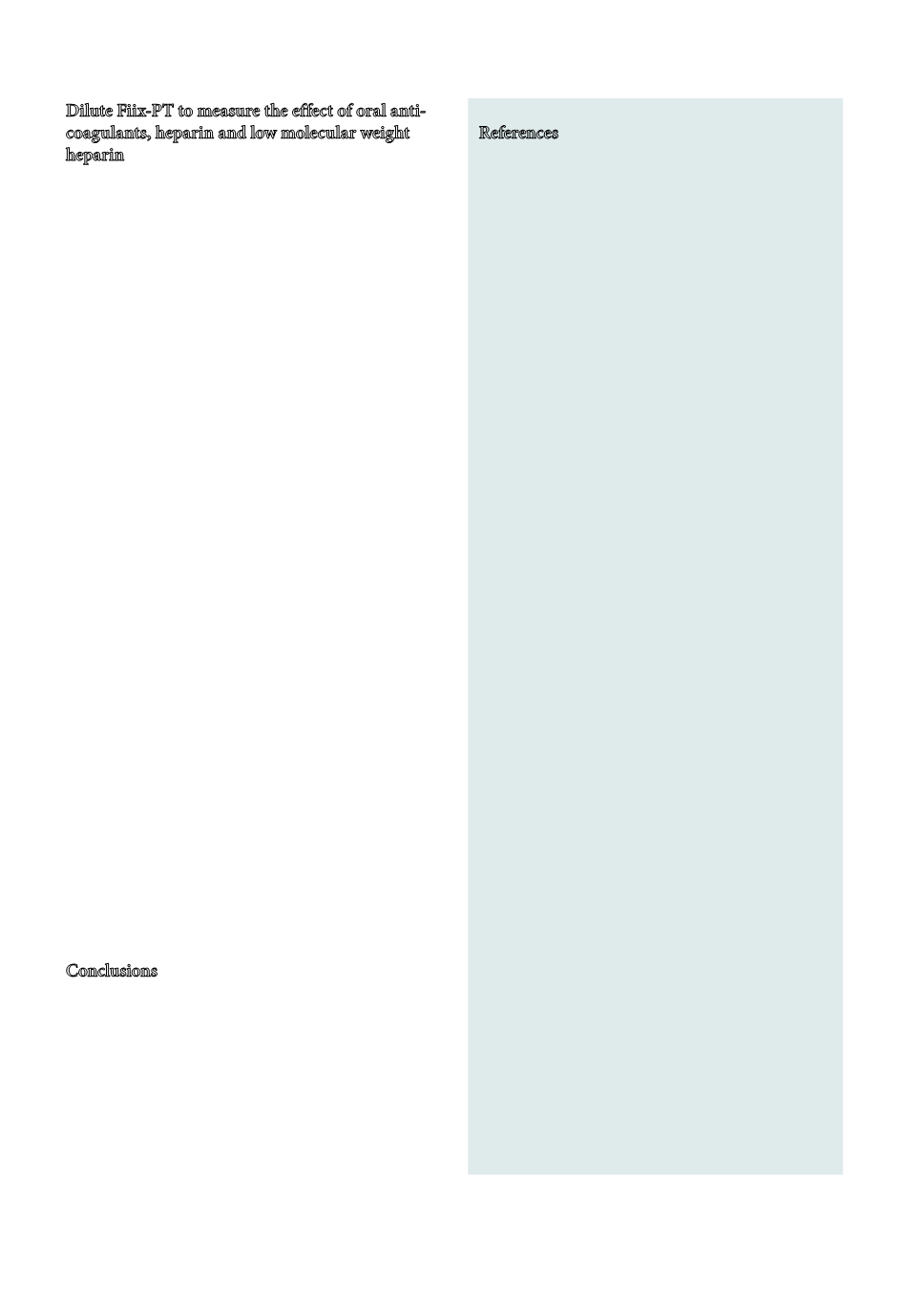
28 |
Klinisk Biokemi i Norden · 2 2017
Dilute Fiix-PT to measure the effect of oral anti-
coagulants, heparin and low molecular weight
heparin
Although all the newDOAC´s are marketed as needing
no monitoring there is agreement that renal function
needs to be monitored during treatment. Moreover,
published data suggests that measuring dabigatran
and edoxaban levels and adapting their dose could help
reduce TE and bleeding (34, 35) but such data has not
been revealed yet on rivaroxaban and apixaban. Most
would agree, nevertheless, that during emergencies
such as major bleeding, preparing for acute surgery, in
trauma patients as well as in the elderly or those with
known renal impairment, it would be useful to be able
to assess the presence or absence of an anticoagulant in
a patient and the level of anticoagulation. This is not
possible at most places today as accurate assays such
as the calibrated dTT (dilute thrombin time) for IIa
inhibitors and calibrated anti-Xa assays are not widely
available on a 24 hour basis. Many smaller laboratories
also do not have the equipment needed for anti-Xa
chromogenic assays. During our experiments to test
the sensitivity of the new Fiix-PT to the influence of
DOACs, we observed that by progressively diluting
the thromboplastin, the Fiix-PT became increasingly
sensitive to all oral anticoagulants tested as well as to
heparin and low molecular weight heparin (enoxapa-
rin) but not fondaparinux. Indeed, further experiments
showed that the dilute Fiix-PT (dFiix-PT) can be used
as a single reagent to assess warfarin and DOAC´s,
using standard coagulation equipment available at
most laboratories while simultaneously reducing any
confounding effect of coagulation factors other than
FII and FX which improves the accuracy of the dilute
assay. This test is easily automated and can be measu-
red day and night. It can also be calibrated to supply
the concentration if the type of drug ingested is known
as opposed to reporting a clotting time (36).
Conclusions
For patients prescribed with VKA it remains important
to improve efficacy and safety. Monitoring warfarin
with the Fiix-PT stabilizes anticoagulation, reduces
dose change frequency, reduces testing need and
appears to reduce TE by almost 50% in the long-term.
The results suggest that the 80 year old prothrombin
time should be replaced during warfarin monitoring
as it contributes to an instable anticoagulation effect.
References
1. Quick AJ, Stanley-Brown M, Bancroft FW. A
study of the coagulation defect in hemophilia
and in jaundice. Am J Med Sci 1935;190:501-11.
2. Owren PA. Parahaemophilia; haemorrhagic
diathesis due to absence of a previously unk-
nown clotting factor. Lancet 1947;1:446-8.
3. Owen CA, Bollman JL. Prothrombin conver-
sion factor of dicumarol plasma. Proc Soc Exp
Biol 1948;67:231-4.
4. Duckert F, Fluckiger P, Matter M, Koller
F. Clotting factor X; physiologic and phy-
sicochemical properties. Proc Soc Exp Biol
1955;90:17-22.
5. Lippi G, Favaloro EJ. Laboratory monitoring
of warfarin in the era of direct oral anticoa-
gulants (editorial comment). Lancet Hematol
2015;2:e223-e224.
6. Owren PA, Aas K. The control of dicumarol
therapy and the quantitative determination of
prothrombin and proconvertin. Scand J Clin
Lab Invest 1951;3:201-8.
7. Kirkwood TB. Calibration of reference
thromboplastins and standardisation of the
prothrombin time ratio. Thromb Haemost
1983;49:238-44.
8. Haraldsson HM, Onundarson PT, Einarsdot-
tir KA, Gudmundsdottir BR, Petursson MK,
Palsson K, et. al. Performance of prothrom-
bin-proconvertin time as a monitoring test
of oral anticoagulation therapy. Am J Clin
Pathol 1997;107:672-80.
9. Gudmundsdottir BR, Francis CW, Bjornsdot-
tir AM, Nellbring M, Onundarson PT. Critical
role of factors II and X during coumarin anti-
coagulation and their combined measurement
with a new Fiix-prothrombin time. Thromb
Res 2012;130:674-81.
10. AgenoW, Gallus AS, Wittkowsky A, Crowther
M, Hylek EM, Palareti G, American College of
Chest P. Oral anticoagulant therapy: Antith-
rombotic Therapy and Prevention of Throm-
bosis, 9th ed: American College of Chest
Physicians Evidence-Based Clinical Practice
Guidelines. Chest. 2012;141:e44S-88S.
11. Jonsson PI, Letertre L, Juliusson SJ, Gud-
mundsdottir BR, Francis CW, Onundarson


